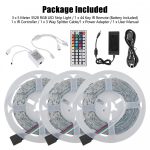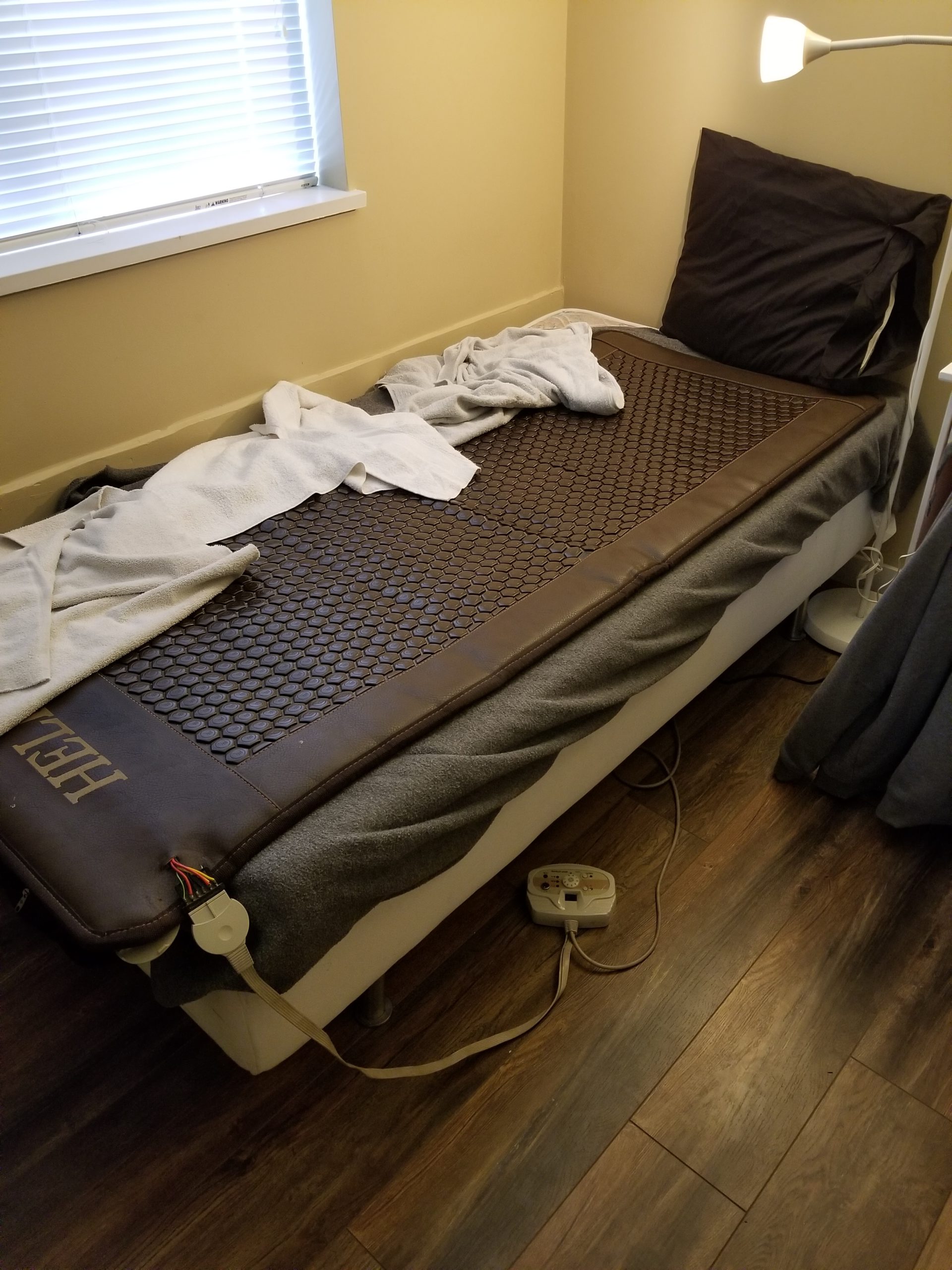Last Updated on 5 months by Francis
Have you ever wondered if an infrared flashlight can blind you? With its invisible light and potential safety risks, it’s important to understand the facts before drawing any conclusions. Let’s delve into the world of infrared flashlights and explore their safety considerations and applications.
Contents
Key Takeaways:
- Although an infrared flashlight emits light outside the visible spectrum, it cannot blind you as it is not visible to the human eye.
- Prolonged exposure to high-intensity infrared light can cause damage to the retina, so caution is necessary when using an infrared flashlight.
- To protect your eyes, avoid shining the light directly into them and consider wearing appropriate eye protection such as goggles or safety glasses.
- Using infrared flashlights responsibly and following safety measures can minimize potential risks and ensure safe usage.
- Infrared flashlights have various applications in security, surveillance, hunting, and outdoor activities where enhanced night vision or heat detection is beneficial.
How Does an Infrared Flashlight Work?
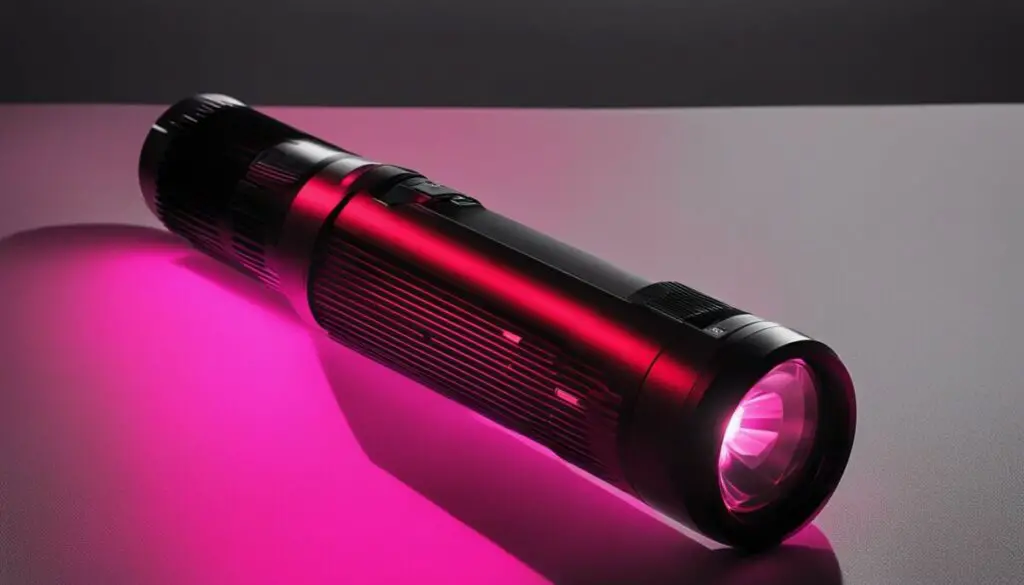
An infrared flashlight works by emitting infrared light, which falls outside the visible light spectrum. Unlike traditional flashlights that emit visible light, the infrared light produced by these flashlights is invisible to the human eye. Instead, it operates in the infrared range of the electromagnetic spectrum.
Infrared light is a form of radiation that has longer wavelengths than visible light. While we cannot see it, it can be detected and captured by specialized cameras and devices designed to capture infrared radiation. These cameras convert the infrared radiation into an image that can be seen by the human eye, allowing us to visualize objects and scenes that would otherwise be invisible.
To generate infrared light, infrared flashlights use specially designed bulbs or LEDs that emit light in the infrared spectrum. The light produced by these bulbs is then focused and projected using lenses and reflectors, similar to how visible light is directed in traditional flashlights. This allows the infrared flashlight to illuminate objects and areas with infrared light, making them visible through infrared imaging technology.
| Key Components of an Infrared Flashlight |
|---|
| 1. Infrared Light Source (Bulb or LED) |
| 2. Lens and Reflector System |
| 3. Power Source (Batteries) |
| 4. On/Off Switch |
| 5. Housing and Body |
Overall, an infrared flashlight operates by emitting infrared light, which falls outside the visible light spectrum. While the light is invisible to the human eye, it can be detected and captured by specialized devices, enabling us to see and navigate in environments that would otherwise be hidden.
Potential Risks of Infrared Flashlights
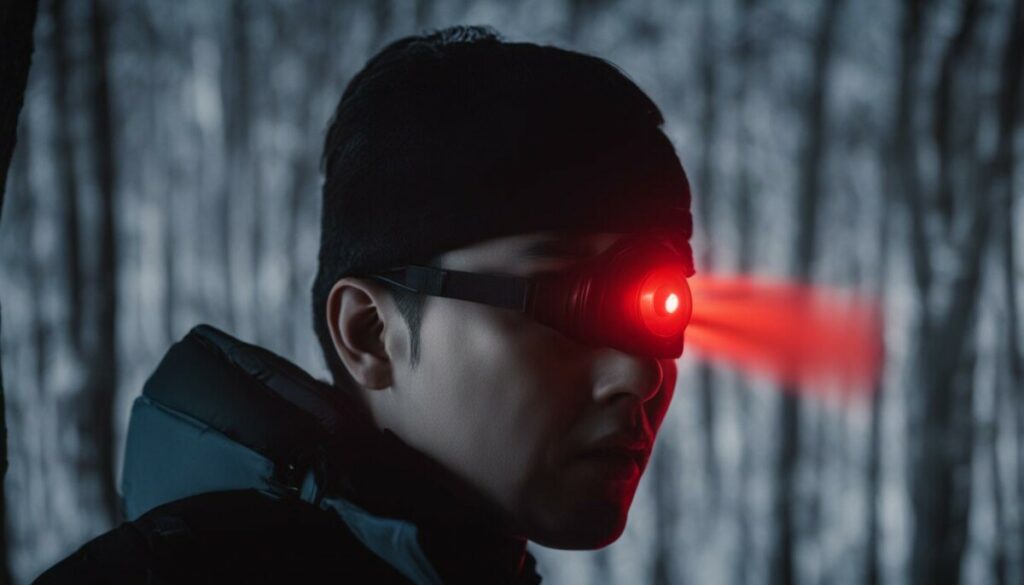
While infrared flashlights may not pose an immediate threat to your eyes, there are potential risks associated with their use. Prolonged exposure to high-intensity infrared light can cause damage to the retina, leading to vision problems. It is important to exercise caution and take necessary safety precautions when using an infrared flashlight to minimize the risk of vision damage.
Direct exposure of the eyes to the intense infrared light emitted by the flashlight can be harmful, especially if done for extended periods of time. The retina, which is responsible for capturing light and transmitting visual images to the brain, can be damaged by prolonged exposure to high-intensity infrared light. This can lead to a condition known as thermal retinal injury, which may result in vision impairments.
“Prolonged exposure to high-intensity infrared light can cause damage to the retina, leading to vision problems.”
To protect your eyes from potential risks, it is recommended to avoid shining the infrared flashlight directly into your eyes. Keep a safe distance from the light source and use the flashlight in a controlled manner. It is also advisable to limit the duration of exposure to the light and take breaks to allow your eyes to rest.
Summary:
- Extended exposure to high-intensity infrared light can damage the retina and cause vision problems.
- Avoid shining the infrared flashlight directly into your eyes to minimize the risk of damage.
- Use the flashlight in a controlled manner and maintain a safe distance from the light source.
- Take breaks and allow your eyes to rest to minimize the strain caused by the infrared light.
By following these precautions and being mindful of the potential risks, you can safely use an infrared flashlight without endangering your vision.
Protecting Your Eyes from Infrared Flashlights
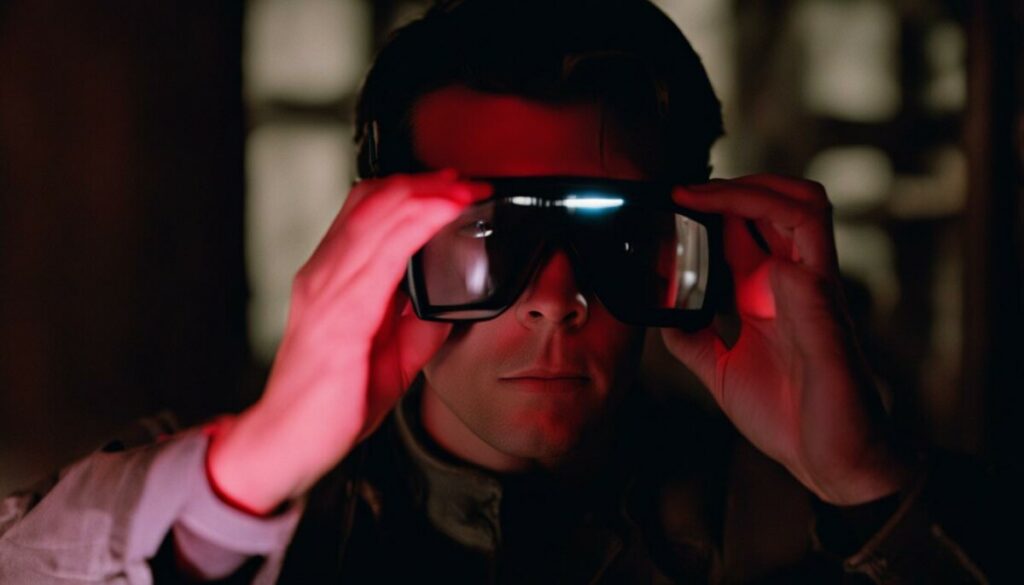
When using an infrared flashlight, it is important to take precautions to protect your eyes from potential risks. The invisible infrared light emitted by these flashlights may not be visible to the naked eye, but it can still pose a danger if used improperly. Follow these safety guidelines to ensure your eye safety while using an infrared flashlight.
Avoid Direct Exposure
To protect your eyes from the potential harm of infrared light, never shine the flashlight directly into your eyes. Even though you may not see the light, it can still cause damage to your retina if exposed for prolonged periods or at close range. Be mindful of the direction in which you point the flashlight and avoid any direct contact with your eyes.
Controlled and Mindful Use
Using an infrared flashlight in a controlled manner can help minimize the risks to your eyes. Be aware of the distance and intensity of the light emitted by the flashlight. Avoid unnecessary exposure by using the flashlight only when needed and for the intended purpose. Remember, it is always better to err on the side of caution when it comes to protecting your eyes.
Eye Protection
Wearing appropriate eye protection, such as goggles or safety glasses, can provide an extra layer of defense against any potential harm from an infrared flashlight. These protective eyewear options are designed to block or filter out harmful infrared radiation. Invest in high-quality eye protection and wear it whenever you use an infrared flashlight to ensure the safety of your eyes.
| Benefits of Protecting Your Eyes: | Risks of Not Protecting Your Eyes: |
|---|---|
| Preserves healthy vision | Potential retina damage |
| Prevents vision problems | Loss of visual acuity |
| Ensures long-term eye health | Possible permanent vision loss |
Remember, your eyes are precious and irreplaceable. Take the necessary steps to protect them from any potential harm while using an infrared flashlight. By following these guidelines, you can safely enjoy the benefits of an infrared flashlight without compromising your eye health.
Infrared Flashlight Safety and Precautions

When using an infrared flashlight, it is essential to prioritize safety to avoid any potential risks. By following a few simple precautions, you can ensure the safe and responsible use of these handy devices.
Proper Handling and Storage
First and foremost, it is crucial to read and carefully follow the manufacturer’s instructions for your specific infrared flashlight model. Understanding the recommended usage guidelines will help prevent any mishaps or accidents. Additionally, always store the flashlight in a safe and secure place when not in use to prevent unauthorized access and potential misuse.
Avoid Direct Eye Exposure
Although infrared light emitted by flashlights is not harmful to the eyes, it is still important to avoid shining the light directly into your eyes. While accidental exposure may not cause immediate harm, it is best to err on the side of caution and apply responsible flashlight etiquette when using infrared devices.
“Using an infrared flashlight responsibly means considering the well-being of yourself and others by avoiding unnecessary eye contact with the light source.”
Regular Inspections and Maintenance
To ensure optimal performance and safety, it is recommended to regularly inspect your infrared flashlight for any signs of damage or malfunction. Check the battery compartment for any corrosion or leakage, inspect the lens for scratches, and test the functionality of the flashlight’s settings. If any issues are detected, consult the manufacturer or seek professional assistance for repairs or replacements.
Summary
By taking the necessary safety precautions, handling your infrared flashlight responsibly, and being mindful of your surroundings, you can enjoy the benefits of this versatile tool without compromising safety. Remember to always prioritize eye safety, follow manufacturer guidelines, and conduct regular maintenance checks to ensure optimal performance.
Misconceptions about Infrared Flashlights
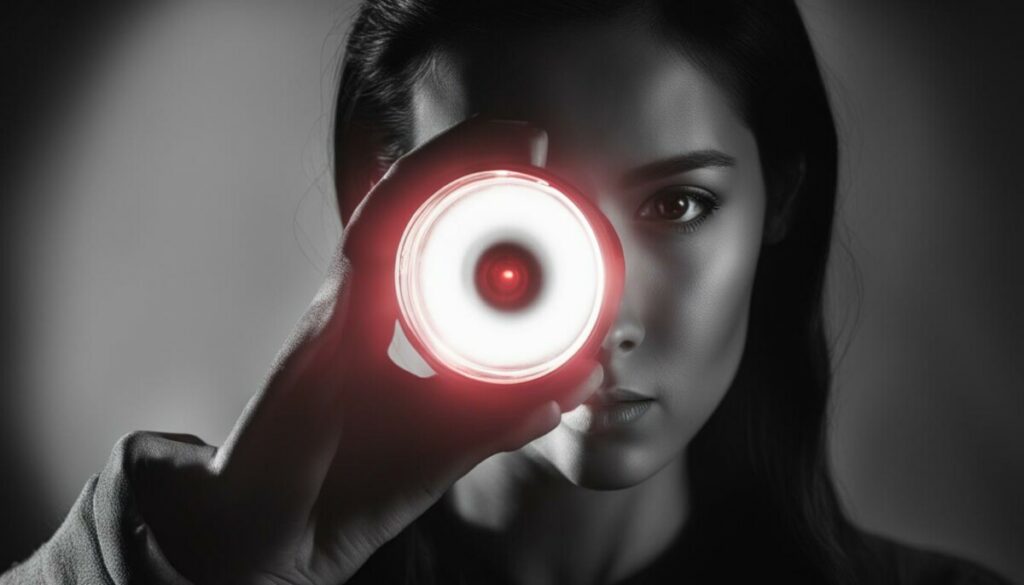
There are several misconceptions surrounding infrared flashlights. One common misconception is that they can blind you. As mentioned earlier, the infrared light emitted by these flashlights is not visible to the human eye and, therefore, cannot blind you. However, it is still important to use caution and follow safety guidelines when using any type of flashlight.
Another misconception is that infrared flashlights are only used by military or law enforcement personnel. While they do have applications in these fields, they are also widely used by outdoor enthusiasts, hunters, and photographers. Infrared flashlights can enhance night vision, detect heat signatures, and improve visibility in low-light conditions, making them valuable tools in various professional and recreational settings.
Additionally, some people believe that infrared flashlights are illegal to use. While it is true that some countries or states may have restrictions on the use of certain types of infrared technology, the use of infrared flashlights is generally legal. However, it is important to familiarize yourself with applicable laws and regulations before using an infrared flashlight to ensure compliance.
In conclusion, it is crucial to dispel these misconceptions and understand the facts about infrared flashlights. They cannot blind you and have various uses beyond military and law enforcement. As long as you use them responsibly, follow safety measures, and comply with applicable laws, infrared flashlights can be valuable tools in enhancing visibility and improving night vision.
The Importance of Infrared Flashlights in Various Fields
Infrared flashlights have a wide range of applications in various fields, making them valuable tools for professionals and enthusiasts alike. Here are some key areas where infrared flashlights are commonly used:
1. Security and Surveillance:
Infrared flashlights are extensively used in security and surveillance applications. They can enhance night vision capabilities, allowing security personnel to monitor areas with reduced visibility. Additionally, infrared flashlights are often used in combination with infrared cameras to detect heat signatures and track movements even in the darkness.
2. Hunting and Outdoor Activities:
For hunters and outdoor enthusiasts, infrared flashlights offer significant advantages. They provide improved visibility during low-light conditions, making it easier to navigate in the dark. Hunters can also use infrared flashlights to track game by detecting the body heat emitted by animals. Moreover, these flashlights are lightweight and portable, making them ideal for outdoor adventures.
3. Search and Rescue Operations:
Infrared flashlights are essential tools for search and rescue operations, particularly in scenarios where visibility is limited. Rescue teams can use these flashlights to locate individuals in dark or hazardous environments. The ability of infrared light to penetrate smoke, fog, and dust particles makes it highly valuable during emergency situations.
4. Industrial Inspections:
Infrared flashlights find extensive use in industrial inspections, primarily for identifying potential issues in electrical systems, machinery, and HVAC systems. With infrared flashlights, technicians can detect abnormalities in temperature variations, which can indicate potential faults or malfunctions. By identifying these issues early on, maintenance and repair activities can be scheduled promptly, preventing costly equipment failures.
These are just a few examples of the diverse applications of infrared flashlights. Their ability to provide enhanced visibility in low-light conditions and detect heat signatures has made them indispensable tools in various fields. Whether it’s for security, outdoor activities, search and rescue, or industrial inspections, infrared flashlights continue to play a vital role in improving safety and efficiency.
| Field | Applications |
|---|---|
| Security and Surveillance | Enhanced night vision, heat signature detection |
| Hunting and Outdoor Activities | Improved visibility, tracking game |
| Search and Rescue | Locating individuals in low-visibility environments |
| Industrial Inspections | Fault detection in electrical and machinery systems |
Legal Considerations for Infrared Flashlight Use

When it comes to using infrared flashlights, it is important to be aware of the legality surrounding their use. While the use of infrared flashlights is generally legal, there may be local or regional laws that regulate their use, especially in sensitive areas or situations. It is crucial to familiarize yourself with the applicable laws and regulations in your area before using an infrared flashlight.
By understanding and complying with these laws, you can ensure that you are using your infrared flashlight responsibly and within the legal boundaries. This not only helps to protect yourself but also ensures that you are respecting the rights and privacy of others.
Situations where legal restrictions may apply
- Law enforcement and military operations: In certain jurisdictions, the use of infrared flashlights or any infrared detection equipment may be regulated due to national security concerns. It is important to adhere to these restrictions and only use such devices within the scope of the law.
- Private property: When using an infrared flashlight on private property, you should always seek permission from the property owner. Trespassing laws may apply if you do not have the necessary authorization.
- Protected wildlife areas: Some wildlife conservation areas have regulations in place to protect animals from disturbance or harm. It is crucial to familiarize yourself with these regulations and avoid using infrared flashlights in prohibited areas.
By being aware of and respecting these legal considerations, you can enjoy the benefits of using an infrared flashlight while staying within the boundaries of the law. Remember to always use your infrared flashlight responsibly and in accordance with the applicable regulations to ensure a safe and enjoyable experience.
| Legal Considerations | Summary |
|---|---|
| Check local and regional laws | Ensure you are aware of any regulations that may restrict the use of infrared flashlights in your area. |
| Obtain permission | Seek permission from property owners before using an infrared flashlight on private property to avoid trespassing. |
| Respect wildlife regulations | Be aware of protected wildlife areas and follow regulations to avoid disturbance or harm to animals. |
Tips for Using Infrared Flashlights Safely
When it comes to using infrared flashlights, safety should always be a top priority. By following a few simple tips, you can ensure the safe and responsible use of these powerful tools.
Tip 1: Read and Follow the Manufacturer’s Instructions
Before using an infrared flashlight, take the time to read and understand the manufacturer’s instructions. Different models may have specific usage guidelines and safety precautions that you need to be aware of. By familiarizing yourself with this information, you can avoid potential risks and maximize the performance of your flashlight.
Tip 2: Avoid Shining the Light Directly into Your Eyes
While infrared light itself is not harmful to the eyes, it is important to avoid shining the flashlight directly into your eyes. This can cause temporary discomfort and may disrupt your vision temporarily. To protect your eyes, always direct the light away from your face and avoid looking directly into the beam.
Tip 3: Use Caution in Sensitive Areas
If you are using an infrared flashlight in sensitive areas such as airports or other secure locations, it is important to exercise caution. Be mindful of local laws and regulations regarding the use of infrared technology in these settings. Always respect the privacy and security of others and use the flashlight responsibly.
Tip 4: Regularly Inspect Your Flashlight
Inspect your infrared flashlight regularly for any signs of damage or malfunction. Check the battery compartment, switches, and overall condition of the flashlight. If you notice any issues, such as cracked lenses or loose connections, it is important to address them before using the flashlight again. Regular maintenance and inspection can help ensure the safe and effective operation of your flashlight.
By following these simple tips, you can use infrared flashlights safely and responsibly. Remember to always prioritize your safety and the safety of others when using any type of flashlight.
Conclusion
In conclusion, the notion that an infrared flashlight can blind you is a misconception. As we have established, infrared light falls outside the visible light spectrum and is not detectable by the human eye. Therefore, the risk of blindness is non-existent when using an infrared flashlight.
However, it is crucial to prioritize safety when utilizing these devices. Prolonged exposure to intense infrared light can potentially damage the retina and lead to vision problems. To protect your eyes, avoid shining the flashlight directly into them and exercise caution when handling the device.
By following proper safety measures, such as maintaining a safe distance, using the flashlight judiciously, and wearing appropriate eye protection, you can minimize any potential risks associated with infrared flashlights. Remember, understanding the facts and using these devices responsibly will ensure that you can reap the benefits they offer without compromising your eye health.
FAQ
Can an Infrared Flashlight blind you?
No, an infrared flashlight cannot blind you as the infrared light it emits is not visible to the human eye.
How does an Infrared Flashlight work?
An infrared flashlight works by emitting infrared light, which falls outside the visible light spectrum and can be detected by specialized cameras and devices.
What are the potential risks of using an Infrared Flashlight?
Prolonged exposure to high-intensity infrared light can cause damage to the retina, leading to vision problems.
How can I protect my eyes from Infrared Flashlights?
It is recommended to avoid shining the light directly into your eyes and to use appropriate eye protection, such as goggles or safety glasses.
What safety measures should I follow when using an Infrared Flashlight?
Read and follow the manufacturer’s instructions, use the flashlight in accordance with its intended purpose, and regularly inspect it for any signs of damage.
What are some misconceptions about Infrared Flashlights?
One common misconception is that they can blind you. However, the infrared light emitted by these flashlights is not visible to the human eye and cannot blind you.
In what fields are Infrared Flashlights important?
Infrared flashlights have various applications in fields such as security, surveillance, hunting, and outdoor activities.
Are there any legal considerations for using an Infrared Flashlight?
It is important to be aware of any local or regional laws that may regulate the use of certain types of infrared technology, especially in sensitive areas or situations.
What tips can you provide for using an Infrared Flashlight safely?
Always read and follow the manufacturer’s instructions, avoid shining the light directly into your eyes, use caution when operating in sensitive areas, and regularly inspect the flashlight for any signs of damage.


